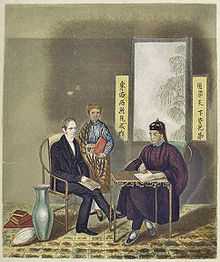Walter Henry Medhurst
| Walter Henry Medhurst | |
|---|---|
 Missionary Walter Medhurst with Choo Tih Lang and a Malay Boy | |
| Born |
April 29, 1796 England |
| Died |
January 24, 1857 (aged 60) London, England |
Walter Henry Medhurst (Chinese: 麥都思, 29 April 1796 – 24 January 1857), was an English Congregationalist missionary to China, born in London and educated at St Paul's School. He was one of the early translators of the Bible into Chinese language editions.
Early life
Medhurst's father was an innkeeper in Ross, Scotland. As a young man Medhurst learned the business of a printer and typesetter at Hackney College. Becoming interested in Christian missions he sailed in 1816 to join the London Missionary Society's station at Malacca, which was intended to be a great printing centre. En route, he called at Madras where, in a little less than three months, he met Mrs Elizabeth Braun, née Martin (1794–1874), marrying her the day before he sailed to Malacca.
Once he arrived, Medhurst quickly became proficient in Malay, in a knowledge of the written characters of Chinese, and in the colloquial use of more than one of its dialects.
Medhurst was ordained at Malacca in 1819, and engaged in missionary labours, first at Penang, then at Batavia - and finally, when peace was concluded with China in 1842, at Shanghai where he founded the London Missionary Society Press (墨海書館) together with William Muirhead, Joseph Edkins, and William Charles Milne. There he continued till 1856, laying the foundations of a successful mission.
Significant books
Medhurst's principal labour for several years, as one of a committee of delegates, was in the revision of existing Chinese versions of the Bible. In 1840, a group of four people (Walter Henry Medhurst, Charles Gutzlaff, Elijah Coleman Bridgman, and John Robert Morrison) cooperated to translate the Bible into Chinese.
The translation of the Hebrew language part was done mostly by Gutzlaff from the Netherlands Missionary Society, with the exception of the Pentateuch and the book of Joshua, which were done by the group collectively.

This translation, completed in 1847 is well known due to its adoption by the revolutionary peasant leader Hong Xiuquan of the Taiping Tianguo movement (Taiping Rebellion) as some of the reputed early doctrines of the organization.
This Bible translation was a version in Classical Chinese, correct and faithful to the original. With John Stronach, and the assistance of Wang Tao, Medhurst later translated the New Testament into the Mandarin dialect of Nanking.
His Chinese-English and English-Chinese dictionaries (each in 2 vols.) are still valuable, and to him the British public owed its understanding of the teaching of Hung-Sew-Tseuen, the leader of the Tai-ping rising (1851–64).
Medhurst was a prolific writer, translator, and editor. The list below is incomplete. In recognition of these learned books, in 1843 New York University conferred upon him the honorary degree of D.D.


Death & memorial
Medhurst left Shanghai in 1856, in failing health.
He died two days after reaching London, on 24 January 1857 and was buried at the Congregationalists' non-denominational Abney Park Cemetery where his white stone obelisk monument can still be seen today.
His son, Sir Walter Henry Medhurst (1822–1885), was British consul at Hankow and afterwards at Shanghai. His obituary was published in the Illustrated London News of 9 January 1886.
Published books
- Medhurst, Walter. A Dictionary of the Hok-këèn Dialect of the Chinese Language: According to the Reading and Colloquial Idioms: Containing about 12,000 Characters (ISBN 1-86210-067-5)
- Medhurst, Walter Henry (1838). China: its state and prospects, with special reference to the spread of the gospel; containing allusions to the antiquity, extent, population, civilization, literature, and religion of the Chinese London: J. Snow. -University of Hong Kong Libraries, Digital Initiatives, China Through Western Eyes
- Medhurst, Walter Henry (1848). English and Chinese Dictionary, Volume 2 Shanghae (Shanghai): Printed at the Mission Press
- Medhurst, Walter Henry (1872). The Foreigner in far Cathay London: Edward Stanford. -University of Hong Kong Libraries, Digital Initiatives, China Through Western Eyes
Notes
References
 This article incorporates text from a publication now in the public domain: Chisholm, Hugh, ed. (1911). "Medhurst, Walter Henry". Encyclopædia Britannica (11th ed.). Cambridge University Press
This article incorporates text from a publication now in the public domain: Chisholm, Hugh, ed. (1911). "Medhurst, Walter Henry". Encyclopædia Britannica (11th ed.). Cambridge University Press- Brief biography (9th paragraph)
| |||||||||||||||||||||||||||||||||||||
| ||||||||||||||||||||||
|

